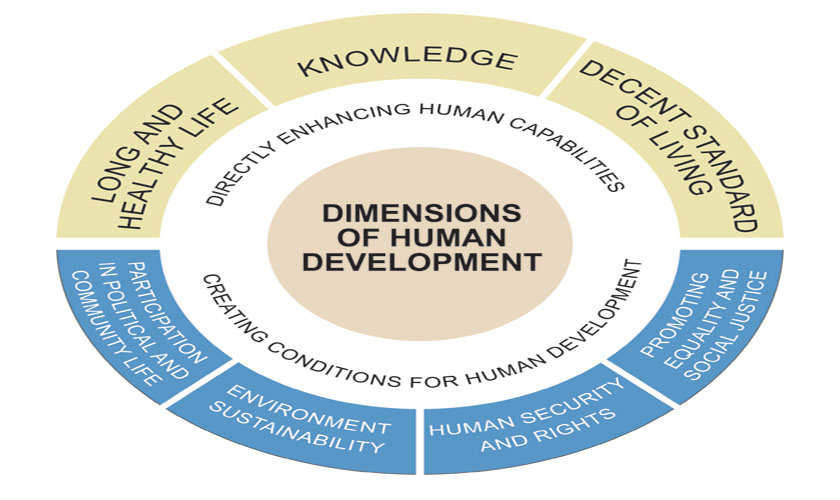DEVELOPMENT
Human Development is the process of enlarging people’s choices. The most important and critical ones are to live a long and healthy life, to be educated, and to avail a decent standard of living. Additional choices are stretching from political, economic and social freedom to opportunities for being creative and productive and enjoying self respect and access to established human rights. Human development has two main components: to be equipped with the human capabilities such as improved health, knowledge and skills and the use people make of their capabilities such as for leisure, productive purposes or being active in cultural, social and political spheres. If these two dimensions of human development are not balanced, considerable human frustration may result. Thus the term human development here covers both the process of widening people’s choices and the level of their achieved well being.
 The progress of nations and their relative standing among other nations have most often been analysed using per capita measures of gross income and output as crude measures of wealth. This 'income/wealth approach' has been criticised as emphasising means over ends and for being too narrow. Building on the work of Amartya Sen and co-authors, a number of academics and policy analysts have championed the human development approach. This alternative approach sees development as the expansion of peoples' capabilities 'to live better and richer lives, through more freedom and opportunity. The progress of the growth of such capabilities has been measured by outcomes as documented in the human development reports.
The progress of nations and their relative standing among other nations have most often been analysed using per capita measures of gross income and output as crude measures of wealth. This 'income/wealth approach' has been criticised as emphasising means over ends and for being too narrow. Building on the work of Amartya Sen and co-authors, a number of academics and policy analysts have championed the human development approach. This alternative approach sees development as the expansion of peoples' capabilities 'to live better and richer lives, through more freedom and opportunity. The progress of the growth of such capabilities has been measured by outcomes as documented in the human development reports.
These reports are regularly published every year to evaluate aggregate outcomes. Foremost among these indexes is the Human Development Index (HDI), which evaluates overall human development. The HDI annual ranking of nations is widely used and is claimed to have the effect of generating competition between nations. The HDI, arguably, has come to rival measures of output, such as per capita Gross National Income (GNI) and per capita Gross Domestic Product (GDP), as the leading measure for evaluating a country's achievement in fostering human well-being.
It attempts to capture overall human development in terms of three primary dimensions: a long and healthy life, knowledge, and a decent standard of living. In formalising the index, these three dimensions are represented, respectively, by life expectancy, education, and per capita GNI. Thus, the HDI is a more general measure of well-being than per capita income. Twenty five years ago the first Human Development Report (HDR) in 1990 began with a simple notion: that development is about enlarging people’s choices—focusing broadly on the richness of human lives rather than narrowly on the richness of economies.
Fast technological growth, globalisation and environmental challenges have transformed the work style and scope. The 2015 HDR, released recently back by the United Nations Development Programme (UNDP), stresses upon governments for timely action in the wake of fast changing situations across the globe. Equitable and fair work for the citizens of a country is the prerequisite for human development. The 2015 HDR report is an urgent appeal to address the most important challenges of development ie providing decent jobs and work opportunities. Most of the nations having very high HDI lie in North America, Europe, and Australia along a little number in Asia.
Pakistan has been lying in the group of nations having low HDI. With an HDI value of 0.538, Pakistan ranks 147th out of 188 nations and territories. Pakistan ranks 121st out of 155 countries in terms of its Gender Inequality Index: only 19.3 percent of women reach secondary education compared to 46.1 percent of men, while female labour force constitutes a 24.6 percent compared to 82.9 percent for men.
 There are many windows of opportunities for Pakistan to tackle the challenges in the current scenario. Its population consists of a major chunk with a 64 percent lying in the age group of below 30 years. It is the need of the hour to utilise the immense potential of young population in the development of the country. Economic changes occurring in the region especially ‘One Belt One Road’ CPEC (China-Pakistan Economic Corridor) can absorb this huge potential, as the said project is supposed to generate jobs and related businesses.
There are many windows of opportunities for Pakistan to tackle the challenges in the current scenario. Its population consists of a major chunk with a 64 percent lying in the age group of below 30 years. It is the need of the hour to utilise the immense potential of young population in the development of the country. Economic changes occurring in the region especially ‘One Belt One Road’ CPEC (China-Pakistan Economic Corridor) can absorb this huge potential, as the said project is supposed to generate jobs and related businesses.
South Asia’s HDI value of 0.607 is still below the average value of 0.666 for the developing world. About 800 million people in South Asia are trapped in the vicious cycle of structured and unstructured poverty in the region. Promoting widespread education, skill development and entrepreneurship can help transform the labour markets.
The writer works at the Social Welfare and Women Development Department, Khyber Pakhtunkhwa